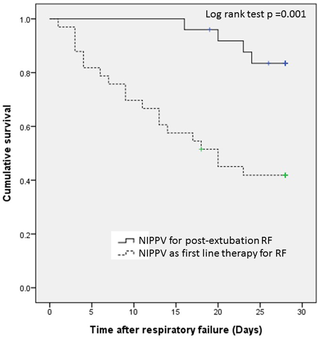PLOS ONE ( IF 2.9 ) Pub Date : 2018-01-12 , DOI: 10.1371/journal.pone.0191204 Wei-Chih Chen , Vincent Yi-Fong Su , Wen-Kuang Yu , Yen-Wen Chen , Kuang-Yao Yang

|
Introduction
Few studies have reported outcomes of lung cancer patients with acute respiratory failure (RF) using noninvasive positive pressure ventilation (NIPPV). The aim of this study was to investigate the prognostic factors in these patients.
Materials and methods
This retrospective observational study included all hospitalized lung cancer patients who received NIPPV for acute RF. It was conducted at a tertiary medical center in Taiwan from 2005 to 2010. The primary outcome was all cause mortality at 28 days after the initiation of NIPPV. Secondary outcomes included all-cause in-hospital mortality, weaning from NIPPV, intubation rate, tracheostomy rate, duration of NIPPV, hospital stay and intensive care unit stay.
Results
The all-cause mortality rate at day 28 of the enrolled 58 patients was 39.66%. The 90-day and 1-year mortality rates were 63.79% and 86.21%, respectively. NIPPV as the first line therapy for RF had higher 28-day mortality rate than it used for post-extubation RF (57.6% versus 16.0%, p<0.05). Independent predictors of mortality at 28 days were progressive disease or newly diagnosed lung cancer (OR 14.02 95% CI 1.03–191.59, p = 0.048), combined with other organ failure (OR 18.07 95% CI 1.87–172.7, p = 0.012), and NIPPV as the first line therapy for RF (OR 35.37 95% CI 3.30–378.68, p = 0.003).
Conclusion
Lung cancer patients using NIPPV with progressive or newly diagnosed cancer disease, combined with other organ failure, or NIPPV as the first line therapy for respiratory failure have a poor outcome.











































 京公网安备 11010802027423号
京公网安备 11010802027423号